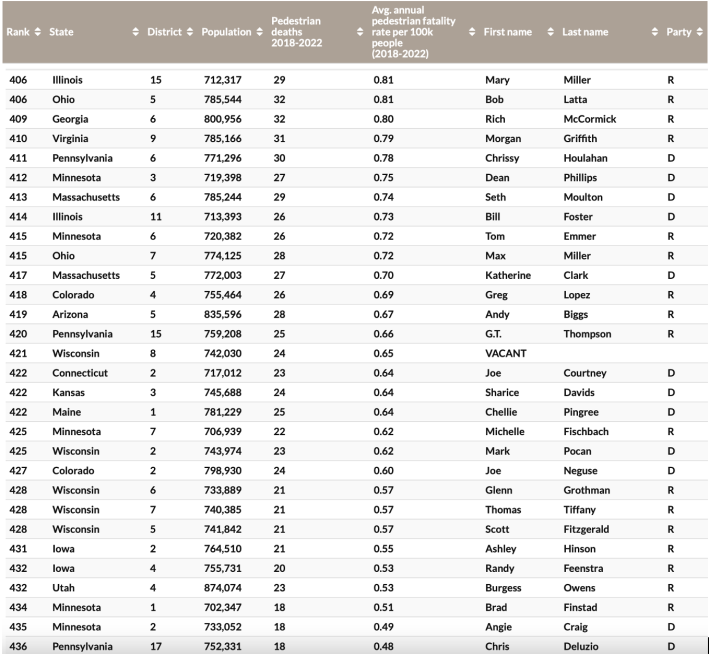Congressional districts with a majority of Black and brown residents are consistently among the most deadly for pedestrians, even when they're located in larger metros that look safer on paper, a new analysis reveals — and their leaders have a unique responsibility to fight for federal funding to stop the carnage.
According to data crunched by Smart Growth America, congressional districts covering portions of Phoenix, Atlanta and Memphis have the highest pedestrian death rates — and all three have populations that were disproportionately non-White during the last census.

That's the case with most of the districts towards the deadlier end of the list, whether they spanned urban downtowns (such as Louisiana's District 2, which encompasses nearly all of New Orleans), sprawling suburbs (like Florida's 10, which is north of Jacksonville and Orlando), or more rural areas such as California's 23rd district (which is mostly made up of the Mojave desert).
And the advocates behind the rankings say that those inequities are the result of decades of systemically racist transportation decisions that Congress can — and must — help to address.
'If you look at where the most dangerous streets are, we know those roads, by and large, are going through communities that are low income and predominantly people of color," explained Steve Davis, Smart Growth America's assistant vice president of Transportation Strategy. "These are places where people who are walking have no other choice, where infrastructure tends to be the worst, where there are overlapping forces that have to do with enforcement and [gathering] the political will to make changes. The people that live in the most dangerous areas are the places where people have the least political capital to make improvements."
You can either be part of the problem or part of the solution. If your city's in the top 30 of this list, [pedestrian safety] should definitely be a burning issue for you.
Steve Davis.
Of course, Congress alone isn't responsible for all of the factors that make communities of color so deadly. With a few exceptions — like Missouri's District 1 in St. Louis and Michigan's 13th, which includes much of Detroit — nearly all of the deadliest districts are in Sunbelt states, where exploding growth, lightning-fast roads, and weather that encourages walking become a recipe for sky-high pedestrian fatalities.
That recipe is made even more potent by the actions of state and local officials, who guide much of America's transportation investments — and too often, direct them towards speeding up traffic, even when Congress makes billions of dollars available to protect people on foot.
Davis argued, though, that federal representatives still play a critical role in setting the tone for their communities' transportation choices, especially when it comes time to reauthorize the country's core surface transportation programs, which they're set to do in 2026.
"You might have a road that's owned, controlled, and maintained by the state, but it runs through multiple congressional districts, and [those representatives] do have the ability to make it better — or make it worse," Davis said. "I don't think congressional reps should be able to dodge the blame for this. You can either be part of the problem or part of the solution. If your city's in the top 30 of this list, this should definitely be a burning issue for you."
Of course, some of the reps on the list are already fighting for the safe streets their constituents need — even if they badly need more allies to win the battle. For instance, the rep for America's single most-dangerous district, the Arizona Democrat Ruben Gallego, succeeded in getting more funding for Complete Streets projects incorporated into the Bipartisan Infrastructure Law; Tennessee Democrat Steve Cohen, who represents the third most deadliest district, helped introduce an improved version of that bill earlier this year. Rep. Hank Johnson (D-Georgia), meanwhile, is currently fighting for $20 billion in operations funding for U.S. transit agencies, and his district ranks 29th.
Still, Davis argued that many of the members of Congress who govern dangerous districts could be doing far more to protect their constituents, even if they voted for the inclusion of modest safety programs in the Bipartisan Infrastructure Law — as did vast majority of the reps on the Democrat-heavy list.

"Even people who are doing good and admirable things and who we think of as champions — it's still not enough," he added. "If you wanted to sum up the [Bipartisan Infrastructure Law's] approach to road safety — which was endorsed by almost everyone in this list — it was, 'If we want to improve safety, let's create some new safety programs.' [But] making small moves and incremental changes is exactly what we've done for the last 10 years, and we've seen these [fatality totals] go in exactly one direction."
To really move the needle on the pedestrian death crisis in their districts and beyond, Davis said Congress should be making bold moves, like urging state Departments of Transportation to do 100,000 quick-build safe infrastructure demonstrations on America's most dangerous roads, no longer allowing agencies to estimate the "value of time" drivers lose sitting in traffic when estimating the benefits of proposed highway widenings, and forcing the National Highway Traffic Safety Administration to deliver pedestrian safety data faster, rather than waiting more than a year to process our annual death totals. And he also says that when the Bipartisan Infrastructure Law expires in two years, they should demand structural changes that treat pedestrian safety as a front-line priority, rather than a pet issue for a handful of specialty grant programs.
"If what we do in the next reauthorization is increase overall funding by 20 percent and pour 20 percent more into programs like Safe Streets for All, when we do this report again in five years, the numbers will be worse," Davis added. "What we really want to see is a much deeper philosophical change."
Find out where your congressional district ranks by visiting Smart Growth America.






